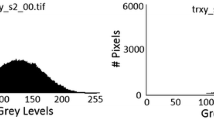Abstract
Viewing transformations like similarity, affine and projective maps may distort planar shapes considerably. However, it is possible to associate local invariant signature functions to smooth boundaries that enable recognition of distorted shapes even in the case of partial occlusion. The derivation of signature functions, generalizing the intrinsic curvature versus arc-length representation in the case of rigid motions in the plane, is based on differential invariants associated to viewing transformation.
Similar content being viewed by others
References
E.J. Wilczynski,Projective Differential Geometry of Curves and Ruled Surfaces (Teubner, Leipzig, 1906)
E.P. Lane,A Treatise on Projective Differential Geometry (University of Chicago Press, 1941).
M. Halphen, Sur les invariants differentiels des courbes gauches, Thesis, J. Ec. Polytechnique, XXVII, 1 (1880).
H.W. Guggenheimer,Differential Geometry (McGraw-Hill, New York, 1963).
Su Buchin,Affine Differential Geometry (Science Press, Beijing, 1983; Gordon and Breach, New York).
D. Cyganski and J.A. Orr, Applications of tensor theory to object recognition and orientation determination, IEEE Trans. Pattern Anal. Machine Intellig. PAMI 7/6(1988)662–672.
D. Cyganski, J.A. Orr, T.A. Cott and R.J. Dodson, An affine transform invariant curvature function,Proc. 1st ICCV, London, 1987, pp. 496–500.
D. Cyganski and J.A. Orr, The tensor differential scale space representation, in:Pattern Recognition Theory and Applications, NATO SAI Series (Springer, 1987) pp. 417–478.
K. Abter, Affine invariant Fourier descriptors,Proc. COST Workshop, Bonas, France, 1988.
K. Abter, W.E. Snyder, H. Burkhardt and G. Hirzinger, Application of affine invariant Fourier descriptors to recognition of 3D objects, IEEE Trans. Pattern Anal. Machine Intellig. PAMI 12/7(1990)640–647.
A.M. Bruckstein, N. Katzir, M. Lindenbaum and M. Porat, Similarity invariant recoginition of partially occluded planar curves and shapes, Technion CIS Report 9003 (1990); also IJCV 7∶3(1992)271–285.
I. Weiss, Projective invariants of shapes, Report CAR-TR-339, Center for Automation Research (1988).
R.F. Vaz and D. Cyganski, Generation of affine invariant local contour feature data, Pattern Recognition Lett. 11(1990)479–483.
A.M. Bruckstein and A.N. Netravali, On differential invariants of planar curves and the recognition of partially occluded planar shapes, AT&T Technical Memo (1990).
A.M. Bruckstein, R.J. Holt, A.N. Netravali and T.J. Richardson, Invariant signatures for planar shape recognition under partial occlusion, CVGIP: Image Understanding 58(1993)49–65.
L. Van Gool, T. Moons, E. Pauwels and A. Oosterlink, Semi-differential invariants,DARPA/ESPRIT Workshop on Invariants, Reykjavik, Iceland, 1991.
E.B. Barrett, P. Payton and M.H. Brill, Contributions to the theory of projective invariants for curves in two and three dimensions,DARPA/ESPRIT Workshop on Invariants, Reykjavik, Iceland, 1991.
I. Weiss, Noise resistant invariants of curves, IEEE Trans. Pattern Anal. Machine Intellig. PAMI 15/9(1993)943–948.
Author information
Authors and Affiliations
Rights and permissions
About this article
Cite this article
Bruckstein, A.M., Netravali, A.N. On differential invariants of planar curves and recognizing partially occluded planar shapes. Ann Math Artif Intell 13, 227–250 (1995). https://doi.org/10.1007/BF01530829
Issue Date:
DOI: https://doi.org/10.1007/BF01530829




